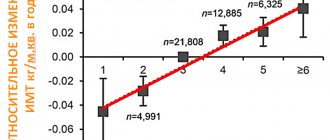The length of a person's step depending on height
There are a number of special devices that count steps while walking; various smartphone applications and fitness bracelets help to do this. But often people are faced with the need to convert the number of steps into distance; this conversion is not as simple as it might seem, since the length of the step is individual.
First of all, this length depends on height; taller people have a longer stride. The size and type of footwear of a pedestrian matters; for example, the step length of the same woman in sports shoes and high-heeled shoes will have large differences.
How to start taking 10,000 steps
Every day a person walks a couple of thousand steps without even giving it any importance. Such walking is considered natural and can also bring benefits to the body. However, to increase this figure to 10,000, efforts must be made:
Buy a pedometer or use special smartphone apps to measure your steps. This will make it much easier to track your progress. Observing the positive dynamics of indicators, additional motivation will appear.
It is better to start gradually so as not to create stressful conditions for the body. If previously the norm was 2,000 steps, then every day this figure can be increased by about 500 steps. This way, there will be time to get used to new loads and at the same time it will be possible to avoid unnecessary overwork.
If you can walk, walk. Instead of using the elevator, you can go down the stairs, travel by transport can be replaced by walking, and at lunch, when you have extra time, you can always walk a little along the floors or corridors. It is better to use your free time from work for active recreation.
To see the positive effects of 10,000 steps for weight loss, you need to combine physical activity with proper nutrition. You shouldn’t limit yourself to food or go on a diet, but food should be healthy and wholesome, and it’s better to avoid snacking on the run.
How many steps are there in a kilometer?
The rule, which is most often used for rough calculations, equates 1 step to 1 m. But such a correspondence is possible only for people with a height significantly above average, walking with a wide gait in comfortable shoes. The most correct way to calculate the length of your own step is to use a navigator in conjunction with a pedometer. Having walked exactly 1 km according to the navigator, you need to see how many steps you have taken.
You can walk a shorter distance, for example, 10 m, and calculate the result, but the longer the distance traveled, the more correct the values are obtained, since the longer distance allows you to avoid rounding numbers and take into account all fluctuations in the pace of walking.
A healthy person 170 cm tall needs to take 1417 steps (hereinafter referred to as W) to cover a distance of 1 km on foot. With a height of 175 cm, to move 1 km, you need to cover 1377 Sh. With a height of 180 cm, the same distance is covered with 1220 Sh. Statistics allow us to take 1250 Sh per 1 km as an average value for men.
The average values for converting kilometers into steps are:
- 2 km is 2500 Sh;
- 3 km – 3750;
- 4 km – 5000;
- 5 km is 6250;
- 10 km – 12500.
It is not at all necessary to remember these values; the recalculation is simple and does not require special skills. For example, having heard the phrase “600 meters on foot,” you can easily calculate that this distance consists of approximately 750 Sh.
Why exactly 15,000 steps?
In a joint study, Time spent in sedentary posture is associated with waist circumference and cardiovascular risk. Three British universities determined the relationship between how much a person walks, sits and stands and the risk of heart disease.
The study involved postal workers from Glasgow: 55 office workers and 56 postmen who delivered mail, mostly on foot. All participants had their body mass index, waist size, blood sugar and cholesterol levels measured - all of these indicators are risk factors for the development of heart disease.
Study participants who spent most of the day sitting had higher body mass index, sugar and cholesterol levels compared to those who moved more.
In fact, for every additional hour spent sitting more than 5 hours a day, subjects increased their risk of heart disease by 0.2%.
Workers who walked 15,000 or more steps each day or stood for 7 or more hours had a normal body mass index, an average waist circumference, and a low risk of metabolic syndrome.
Metabolic syndrome - an increase in visceral fat mass, a decrease in the sensitivity of peripheral tissues to insulin and hyperinsulinemia, which disrupt carbohydrate, lipid, purine metabolism, as well as arterial hypertension.
"Wikipedia"
Moreover, the risk of cardiovascular disease among mobile workers was significantly lower than among those who walked fewer than 15,000 steps per day.
The researchers suggested that this is the number of steps that should be targeted to reduce the likelihood of developing heart disease.
How long does it take to walk 1 kilometer?
The speed of movement, like the length of the step, depends on many parameters: pace, gait, physical fitness of the pedestrian, type of shoes, terrain. It is generally accepted that the average walking speed for a healthy adult is 5 km/h. A simple recalculation shows that the average person covers 1 km in 12 minutes.
But the walking pace can be increased. If you walk quickly with a sweeping gait, then the increased speed will allow you to walk 1 km in 10 minutes, and a well-trained person can do it in 7-8 minutes.
How many calories do 10,000 steps burn?
Many people strive to lose weight by walking. Since walking can be equated to long-term aerobic training that affects the breakdown of fat, this result is achievable (in combination with the right diet).
The pace of walking and the amount of excess weight are important (the more weight there is, the faster calories will be burned). Some pedometers have a calorie counting function, but you can do this calculation yourself using a specially developed formula. To do this, multiply the length of one step (in meters) by their number, then multiply by the person’s weight in kilograms, divide the resulting value by 2. The result will show the number of calories burned.
For example, a person weighing 80 kg with a stride length of 0.7 m walked at an average pace of 10,000 steps. Multiplying the last 2 numbers, we get the distance traveled - 7000 m. Multiply by weight 80 kg, and divide the result by 2. It turns out 280,000 cal or 280 kcal. This is the amount of energy a person burns after walking 10,000 steps. When walking fast, the same person can burn about 2 times more.
The effectiveness of losing weight through walking can be increased by using Nordic walking with poles. This style of physical activity has a number of advantages, since it loads not only the legs, but also the arms and shoulders. Involving the upper limbs in the walking process evenly loads most of the body's muscles.
Nordic walking is good not only for more efficient burning of calories, it improves cerebral circulation, relieves tension from all parts of the spine, strengthens the muscles of the shoulders, arms, back and ligaments in this area, increases coordination and concentration.
How to increase walking efficiency?
To lose weight, it is not enough to just walk occasionally. You need to walk regularly, and always try to increase the effectiveness of such physical activity.
Athletes, coaches and nutritionists recommend:
- Walk strictly according to a schedule, for example, choose 3-4 times a week, and in the morning.
- Walk exclusively in a good mood and when there is no general malaise or any diseases.
- Do not eat an hour before the start of your workout and limit your fluid intake.
- Wear only comfortable clothes, preferably a tracksuit, and sneakers (or sneakers).
- Take a small load with you, for example, put on a backpack in which you put 2 - 3 small books.
- Wrap thighs with cling film.
Also, to increase efficiency, nutritionists and athletes advise:
- eat only right and never overeat;
- three hours before bedtime, drink exclusively plain water;
- no alcohol or smoking;
- after walking, do simple exercises, for example, bending in different directions, shallow squats, or gentle swings of the legs.
How many steps should you take per day?
The World Health Organization (WHO) recommends that the average healthy person take 8,000 to 10,000 steps per day. This indicator appeared in the 60s. last century in Japan, after active advertising by a pedometer manufacturer, the creators of the electronic device presented 10,000 steps as a daily norm. Although the 10,000 number has not been backed up by any research, many walkers around the world have begun to aim for this number when walking.
Subsequently, noting positive results in people taking 10,000 steps per day for a long time, WHO reflected this parameter in its recommendations. Skeptical experts believe that such a norm was correct for the middle of the last century, when people ate more restrainedly, and in the process of life they moved much more than today, so the modern value of the norm is proposed to be doubled.
Other critics believe that walking is not as important as physical activity itself, which can be achieved in any way, for example, in the gym, swimming pool or even at home. But proponents of walking believe that this method has many benefits, combining benefits with the opportunity to spend quality time outdoors. Whether you take 10,000 or 8,000 steps, or even 5,000, it’s better than nothing, every thousand makes an undoubted contribution to health benefits.
Norm of steps per day for men
10,000 steps per day is an average recommended value, which is not universal. In addition to differences when taking into account age, weight and health status, this indicator differs for men and women. So, healthy adult men under 50 years of age should walk at least 12,000 Sh per day; after 50 years, this number can be reduced by 2,000, and then be guided by individually selected values.
Norm of steps per day for women
The recommended number of steps per day for women differs slightly from similar values for men:
- for women aged 18-40 years – 12,000 Sh;
- 40-50 years -11000;
- 50-60 years – 10000;
- after 60 years – 8000.
At an older age, the concept of the norm is significantly adjusted taking into account individual characteristics. Children from 7 to 10 years old can walk 15,000 steps a day (or more), regardless of gender.
Do not forget that in the process of life we make many more movements than a pedometer allows us to take into account. If a person at work is engaged in physical labor or often moves on his feet, then daily walking can be reduced to 7,000 or 6,000 steps. The number of steps must also be adjusted when visiting the gym, swimming pool or exercising at home.
Why 10,000 steps
Now many people consider the expression that if you walk 10,000 steps a day, you can live about 100 years, some kind of eastern wisdom that has existed from time immemorial. In fact, everything is not so prosaic. About 50 years ago, Yoshiro Hatano wrote a research paper on the benefits of walking, which became the basis for the creation of the first electronic step meter. This one-of-a-kind gadget was called Manpo-Kei, which in Japanese literally translates to “10,000 step meter.” Thus, this theory was initially just a successful marketing ploy, with the help of which tens of thousands of devices were sold.
Hatano was inspired to create a pedometer by thinking about the quality of life of his compatriots. He noticed that over time, the Japanese began to adopt the behavior habits of the Americans, who predominantly lead a sedentary lifestyle and do not think much about maintaining their health. To increase the activity of the population, Yoshiro began to convince people of the benefits of walking: if a person can walk more than 4,000 steps a day, he will burn more calories, which means his body will always be fit and healthy. This statement did not go unnoticed, and soon thousands of people began to increase their physical activity by measuring the number of steps.
Despite the fact that the theory initially appeared as part of an advertising campaign, scientists subsequently conducted the necessary studies that were able to prove the positive effects of 10,000 steps a day on the body. In order for the muscles to always be in good shape and the cardiovascular system to work like a clock, a person should take about 10-12 thousand steps during the day. However, 10,000 steps is how many in kilometers? Adjusting for step length, on average you need to walk about 6-8 km per day. Not much, however, this distance can become difficult for city residents.
In order to sleep longer, on weekdays a person leaves a little time in the morning in order to get to the office as quickly as possible. At the end of the day, he wants to quickly be home and relax, lounging on the sofa. This lifestyle is not very beneficial for the body and sooner or later will cause a lot of discomfort for health. For comparison, our distant ancestors covered an unimaginable distance of 20 km a day, and they would have lived happily ever after if not for other negative factors of that environment. To keep your body healthy, you can replace public and personal transport with walking. If you can walk to work in the morning and evening, then why not take a walk and benefit your body?










